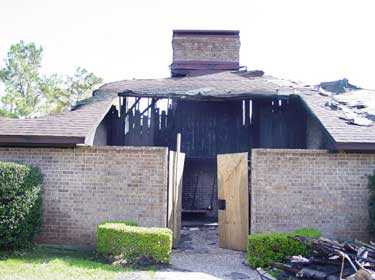One Probationary Career Firefighter Dies and Four Career Firefighters are Injured at a Two - Alarm Residential Structure Fire - Texas
This report was revised on January 5, 2007.
 Death in the Line of Duty...A summary of a NIOSH fire fighter fatality investigation
Death in the Line of Duty...A summary of a NIOSH fire fighter fatality investigation
F2005-02 Date Released: September 16, 2005
SUMMARY
On December 20, 2004, a 24-year-old male career probationary firefighter (the victim) died after he became separated from a fire-attack team at a two-alarm, single-story, residential structure fire. The fire-attack team and a search and rescue team entered the structure through the front entrance. After approximately four minutes, the crews the victim was operating with had to perform an emergency evacuation from the structure due to intensifying, uncontrollable fire conditions. Immediately after the evacuation, a personnel accountability report (PAR) was called, and soon after, the crews realized that the victim was missing. The rapid intervention team (RIT) team attempted to search for the victim, but was unable to make entry due to the fire conditions. The victim was found approximately 15 minutes after the PAR, about 15 feet from the point of entry (Diagram 1). The victim was pronounced dead on-scene by the county medical examiner.
NIOSH investigators concluded that, to minimize the risk of similar occurrences, fire departments should:
- ensure that a complete size-up is conducted prior to making an offensive attack.
- ensure that risk vs. gain is evaluated prior to making entry in fire-involved structures.
- develop standard operating procedures (SOP’s) for advancing a hose line in high-wind conditions.
- ensure that team continuity is maintained.
- ensure that a backup hose line is pulled and in place prior to entry into fire-involved structures.
- consider using a backup manual personal accountability safety system (PASS) device in combination with self-contained breathing apparatus (SCBA) equipped with integrated PASS devices.
- provide SCBA face pieces that are equipped with voice amplifiers for improved interior communications.
- ensure that hose lines are not pulled from the burning structure when it is possible that a missing firefighter is in the structure.
- train firefighters on initiating emergency traffic (Mayday-Mayday) and manually activating their PASS alarm when they become lost, disoriented, or trapped.
- instruct firefighters to not overcrowd the area of the interior attack team.
INTRODUCTION
On December 20, 2004, a 24-year-old male career probationary firefighter (the victim) died after he became separated from his crew while performing a fire attack operation at a two-alarm, single - story residential structure fire.
On December 21, 2004, the State Fire Marshal’s office and the U.S. Fire Administration (USFA) notified the National Institute for Occupational Safety and Health (NIOSH), Division of Safety Research (DSR), of the fatality. On March 8-11, 2005, the NIOSH DSR Chief of the Fatality Investigations Team and two DSR engineers performed an on-site investigation. Meetings and interviews were conducted with the Chief and officers of the department, firefighters, and other rescue personnel involved in this incident. NIOSH investigators also reviewed copies of the department standard operating procedures (SOPs), diagrams of the incident, training records, photographs, witness statements, run sheets, dispatch tapes, the coroner’s report, the State Fire Marshal’s report, and inspected the victims’ turnout gear, self-contained breathing apparatus (SCBA), and related equipment.
The DSR investigation team initiated an evaluation of the Personal Alert Safety System (PASS) device integrated into the 4500 p.s.i., 30-minute, self-contained breathing apparatus (SCBA) worn by the victim at the request of the Chief of the Fire Department. A summary of the results of the PASS device testing is attached to this report as an appendix.
Department
The career fire department involved in this incident has 5 front-line responding apparatus, 5 stations, 86 uniformed firefighters and serves an urban population of approximately 67,000 in an area of about 35 square miles.
Victim’s Training and Experience
The victim had graduated from a State-Certified fire academy in 2002, after receiving 560 hours of firefighter training. The victim had also completed 64 hours of continuing education credits related to firefighting since becoming a probationary firefighter with this department.
Apparatus / Equipment
First Alarm
Battalion Chief 1 (B-1) : on-scene 1515 hours
**Engine/Ladder 1 (EL-1) – Lieutenant (Lt.), 3 firefighters (FFs): on-scene 1515 hours
Engine Company 5 (E-5) – Lt. , 3 FFs: on-scene 1517 hours
Engine Company 2 (E-2) – Lt., 3 FFs: on-scene 1518 hours
Medic 2 (M2): on-scene 1520 hours
Engine Company 3 (E-3) – Lt., 3 FFs: on-scene 1521 hours
** The victim was assigned to EL-1.
Second Alarm
Engine Company 4 (E-4) – Lt., 3 FFs
Medic 1, 3
Volunteer mutual aid company (30 minute travel time)
Structure
The one-story residential structure was approximately 3,700 sq. ft. in size, and was built in 1976 of wood-frame construction, with a brick veneer exterior and a free-standing interior fireplace. The roof of the involved structure was of composition shingles (over wood shingles in some areas). The structure was heated and cooled via electricity. All entrances and windows of the structure were secured with burglar bars/swinging wrought-iron gates/doors. (Photo 1) The two-car garage at the west end of the structure had one large, wooden door. There was a glass sliding door at the south (side-C) end of the structure. The owner of the home was not home at the time of the incident. The living area and layout of the structure are depicted in Diagram 1.
Weather
The weather conditions at the time of the incident included 14 mph winds out of the south-southwest, gusting to 31 mph. The ambient temperature was 66 degrees F, with a relative humidity of 56%. (Note: it is the opinion of the NIOSH investigators that the wind, which was reportedly gusting from side-C to side-A [side of entry] of this structure, played a considerable role in the fire spread at this incident.)
INVESTIGATION
On December 20, 2004, at 1511 hours, the 911 center received a telephone call of a house on fire. The initial report was from a telephone company employee working in the area. He told the 911 dispatcher that he could see smoke coming from the eaves. Additionally, he stated that he could hear alarms “going off” inside the house and “it didn’t look like there was anybody at home.” The caller also stated that the fire department would have a “fun time getting in” because the home was covered in burglar bars.
At 1511 hours, the 911 center dispatched the first alarm. All responding units were en-route within 2 minutes of the alarm. B-1 was first on scene at 1515 hours, followed closely by EL-1. B-1 set up a stationary command post in his vehicle on side-A and assumed incident command (IC), and EL-1 positioned directly in front of the residence on side-A.
The IC reported light smoke visible from a large one-story residence, and immediately assigned EL-1 to perform entry and “fast attack.” A 1-3/4 inch pre-connect was pulled off of EL-1, and was taken to the front door, but immediate entry was not possible due to the locked burglar bars/gate over the door. The Lieutenant from EL-1 sent the victim back to EL-1 to retrieve a K-12 saw for forcible entry through the front door. E-5 and E-2 arrived and staged on side-A at 1517 and 1518 hours, respectively. E-5 and E-2 were assigned by the IC to assist EL-1 with forcible entry and then to perform a primary search. Firefighters from E-2 brought irons (axe and haligan bar) as they disembarked the engine, and made entry about the same time that the victim had returned from EL-1 and started the K-12 saw.
At approximately 1519, the point in time that the front door was forced open, the IC noted that smoke rolled out at the mid-level of the door. EL-1 (Lt. and two fire fighters) immediately went inside with the line (it was later determined that EL-1 progressed approximately 15 to 20 feet into the structure) and E-2 entered immediately after EL-1. At about the same time the crews were making entry, the IC was informed by a neighbor that if there was a car in the garage, the resident was at home. At 1520 the IC requested E-2 to bring a second line stretched around to the right side of the garage and ordered that the garage be opened. The IC asked E-2 if that could be handled, but there was no response from E-2. At this point, the E-2 crew had already entered the structure with the EL-1 crew and had initiated search and rescue operations. At 1521, E-3 arrived and was assigned to be the rapid intervention team (RIT). The garage door was not opened. (Note: After extinguishment it was determined that there was no car in the garage.)
Meanwhile, due to congestion (6 firefighters) immediately inside the door, the E-5 crew staged at the entranceway on side-A. When the EL-1 and E-2 crews made entry, they came into contact with the back of the brick fireplace (Diagram 1) directly in front of and approximately 4 feet inside the front entrance of the structure. The crews (2 Lt’s and 4 firefighters) both turned to the right of the fireplace to enter the structure, and began searching for the seat of the fire. Members from E-2 were operating a thermal imaging camera (TIC) in the immediate vicinity of the EL-1 crew / hand line. It was stated by the Lt. from EL-1 that he thought that the victim might have stayed at the front door to feed hose. The Lt. and firefighter from EL-1 (nozzle-man) advanced the line, and the nozzle-man reportedly hit a window with a stream at the west end of the house, which broke out. The EL-1 Lt. and the nozzle-man then advanced the hose line further into the structure, and the nozzle-man told his Lt. that it was too hot, and that his hands were “burning up”. The EL-1 Lt. told him to hit the area to the left at ceiling level, which was done and the fire blackened down. The EL-1 Lt. then told the nozzle-man that the fire was also to the right. The hand line was opened again for a longer burst, then it was shut down again. It was at this point that the nozzle-man was forced to set down the hand line, handing the nozzle to the EL-1 Lt., and stating that he was too hot. The Lt. from EL-1 stated that fire immediately began rolling down to about knee level above the floor. All interior firefighters were immediately overcome by intense heat and flames. The Lt. from EL-1 stated that the Lt. from E-2 was trying to communicate with him, but he could not understand what he was saying. All he heard was yelling and a muffled voice. (Note: it was later stated by the Lt. from E-2 that he was trying to convey that they needed to bail out.) At this point, the fire intensified further to the left and right, and it was reported that all at once it sounded like firefighters were yelling “back out, back out” and “bail out.” Also at that point, the EL-1 Lt. yelled to the E-2 Lt. that they needed to back out. The EL-1 and E-2 Lts. stated that they yelled for everyone to get out, and it was about that time that the EL-1 Lt. believed that he, himself, was on fire. The EL-1 Lt. then set the nozzle down and followed other firefighters and the hand line out.
The crew from E-5 (staged at the front door, side-A) (Photo 1) stated that only minutes after entry was made, they heard muffled yelling and firefighters began crawling and running out of the structure. The E-5 crew began assisting the firefighters, as their gear was either smoking, or on fire. At this time, the E-3 (RIT) crew was approaching the front door. The time was approximately 1523 hours, less than four minutes after initial entry was made. The E-5 Lt. stated that he ran over to the IC command post and informed him that they had firefighters down, and to call for additional EMS units. The IC immediately called for a second alarm (Note: the second alarm for this department is a single engine (E-4) and the dispatch of a volunteer fire department, which reportedly had an approximate 30-minute response time.) The IC also called for additional EMS units (2 additional) and a PAR. E-2 reported that they had a PAR. EL-1 also initially reported they had a PAR, but then immediately radioed back (as they were removing their hot and/or burning gear) that they did not have a PAR. The IC immediately notified dispatch that a firefighter was missing. Immediately afterward, the RIT team (E-3 crew) was activated, but reported at 1528 hours that although attempts were made, they could not make entry due to the intense fire conditions. The IC ordered a defensive attack mode. It was at this time that the RIT team pulled the hand line out of the structure and used it to try to knock the fire down. At 1528, after conditions continued to worsen, the decision was made to set-up and use the deck-gun (deluge) on E-5 to knock the fire down. The driver-operators from E-5 and E-3 had, by this time, hooked up EL-1 to a hydrant, and had begun flowing supply water. In addition, a 3” supply line was laid from EL-1 to E-5. At 1531, the deck gun was opened on E-5, which was staged at the driveway of the residence (Diagram 2). Also at 1531 hours, E-4 (the last available fire department apparatus) arrived on scene with a Lt. and three firefighters. Two firefighters of the E-4 crew were sent around to the rear of the house to flow water with a 1 3/4” hand line in the direction from side-C to side-A. (Diagram 2) (Note: at this point in the defensive/recovery operation, the hose line at the rear was operating in the same direction as the wind – and was opposing the deck gun from E-5 and the initial attack line that the RIT team was operating at the front). After approximately two minutes of flowing water from the E-5 deck gun, the IC ordered the Lt. from E-4 to find a partner and make entry to find the victim. At approximately 1533 hours, the Lt. and a firefighter from E-4 made entry through the front door, searched to the right, and eventually found the victim approximately 15 feet from the front door, in an area where the original attack-line had been advanced. The victim was removed at 1541 – at approximately the same time that a structural collapse occurred at the rear (side-C) up to the chimney (Photo 2). The victim’s SCBA face piece was in place. His gear and SCBA was badly damaged by the heat of the fire, and it was noted by rescuers that the PASS device was not sounding.
Cause of Death
According to the County Medical Examiner, the cause(s) of death were listed as thermal injuries and smoke inhalation.
RECOMMENDATIONS/DISCUSSIONS
Recommendation #1: Fire departments should ensure that a complete size-up is conducted prior to making an offensive attack.
Discussion: The process of conducting a size-up includes the consideration of many factors, which include a 360 - degree walk-around and assessment of the type of building construction, location of doors and access to the structure, occupancy and contents of the structure, location of the event in the structure, time of day and weather conditions, time of the alarm, and day of the week.1
Complete size-ups of fire incidents assist the IC in determining needed and available resources, and making a sound strategy prior to making an offensive, interior attack that increases safety risks for firefighters.2
Recommendation #2: Fire departments should ensure that risk vs. gain is evaluated prior to making entry in fire-involved structures.
Discussion: NFPA 15003 Section 8.2: Risk Management During Emergency Operations, states that “The incident commander shall integrate risk management into the regular functions of incident command." Additionally, NFPA 1500 notes that “The concept of risk management shall be utilized on the basis of the following principles:
- Activities that present a significant risk to the safety of members shall be limited to situations where there is a potential to save endangered lives.
- Activities that are routinely employed to protect property shall be recognized as inherent risks to the safety of members, and actions shall be taken to reduce or avoid these risks.
- No risk to the safety of members shall be acceptable when there is no possibility to save lives or property.”
The NFPA 1500 Annex A.3.3.47.1 provides information that will assist in determining offensive vs. defensive operations and reads: “Defensive operations are generally performed from the exterior of structures and are based on a determination that the risk to personnel exceeds the potential benefits of offensive actions.”3 Simply stated, risk vs. gain is an evaluation of the potential benefit that a task will accomplish, weighed against the potential risks to fire personnel. Basic guidelines are outlined in the Fire Fighter’s Handbook:
- Firefighters will take significant risk to save a known life
- Firefighters will take a calculated risk, and provide for additional safety, to save valuable property or reduce the potential for civilian and firefighter injuries
- Firefighters will take no risk to their safety to save what is already lost.4
It was not determined whether the resident was home at the time of the incident, According to a neighbor that informed the IC, if there was no car in the garage, then the resident was not home.
Recommendation #3: Fire departments should develop standard operating procedures (SOP’s) for advancing a hose line in high-wind conditions.
Discussion: Fire departments should develop SOP’s that would help protect firefighters by developing alternate strategies, including defensive attack if necessary, in incidents with high-wind conditions. Weather can be considered as critically important when at the extreme, and relatively unimportant during normal conditions.2 According to Dunn, “When the exterior wind velocity is in excess of 30 miles per hour, the chances of conflagration are great; however, against such forceful winds, the chances of successful advance of an initial hose line attack on a structure fire are diminished. The firefighters won’t be able to make forward hose line progress because the flame and heat, under the wind’s additional force, will blow into the path of advancement.”5 This phenomenon was reportedly what occurred at this incident. According to the Texas State Fire Marshal’s report, the wind at the time of the incident was 31 miles per hour, blowing from side-C to side-A. The fire and heat were advanced toward attacking firefighters as soon as they opened the door on side-A, and reportedly intensified further when the window on the C- side was broken out by the water stream (when the firefighters made entry and initial attack, before being overcome by heat and flames and forced to retreat minutes later). As the interior crews quickly retreated, the victim apparently became separated, lost, and overcome by the advancing heat and flames.
Recommendation #4: Fire departments should ensure that team continuity is maintained.
Discussion: Team continuity involves knowing who is on your team and who is the team leader, staying within visual contact at all times (if visibility is obscured then teams should remain within touch or voice-distance of each other), communicating your needs and observations to the team leader (officer), rotating to rehab and staging as a team, and watching your other team members (practice a strong “buddy-care” approach).2 These key factors help to reduce serious injury or even death resulting from the risks involved in fire-fighting operations by providing personnel with the added safety net of fellow team members. As teams enter a hazardous environment together, they should leave together to ensure that team continuity is maintained.4 In this incident, the location and activities of the victim were not known by his team at any point after initial entry was made.
Recommendation #5: Fire departments should ensure that a backup hose line is pulled and in place prior to entry into fire-involved structures.
Discussion: Klaene and Sanders [pp. 280-281, 366] state that “backup lines are needed to protect the crew on the initial attack line and to provide additional flow if needed. Backup lines should be at least as large as the initial attack line,” and, “Backup lines should always be in place to protect exit routes.” In this incident, there was no backup line at the front entrance, and when the RIT team needed to attack the fire in order to make entry to search for the victim (immediately after he was identified as being lost), they pulled the attack line out of the structure, which removed a potential lifeline for the victim.
Recommendation #6: Fire departments should consider using a backup stand-alone personal accountability safety system (PASS) device in combination with self-contained breathing apparatus (SCBA) equipped with integrated PASS devices.
Discussion: PASS devices are electronic devices worn by the firefighter, which will emit a loud and distinctive alarm if the firefighter becomes motionless for a specified period of time (e.g. 30 seconds). Firefighters entering hazardous areas should be equipped with a PASS device. There are several types of PASS devices available. One device that could be used is a PASS that is integrated into the SCBA and is automatically activated when the air is turned on.6 A stand-alone PASS is a device that is not an integral part of any other item of protective clothing or protective equipment. Stand-alone PASS devices are also used throughout the fire service. Stand alone PASS devices are often worn on the SCBA strap, and it is required that they have automatic activation. Used in combination, the manual and integrated PASS systems would provide a back up device should one or the other device fail, and will offer a second emergency alarm for firefighters should they become lost, disoriented, or trapped. In this incident, all SCBA’s were equipped with integrated PASS devices, but witnesses stated that the victim’s integrated PASS device was not in alarm mode (it was not sounding an audible alarm) when the rescue-crew found him – approximately 15 feet from the front entry/exit.
Recommendation #7: Fire departments should provide SCBA face pieces that are equipped with voice amplifiers for improved interior communications.
Discussion: Communication between fire fighters while wearing a SCBA face piece, particularly in a burning building, is difficult. Many SCBA face pieces muffle and distort the voice of the fire fighter wearing them under normal conditions and circumstances. Several manufacturers now offer battery-powered voice amplifiers with electronic emitters that mount directly to the compatible SCBA face piece, and allow the voice of the SCBA wearer to be amplified and projected a much greater distance, and with higher clarity. In this investigation, firefighters reported having significant difficulty understanding communications inside the burning structure.
Recommendation #8: Fire departments should ensure that hose lines are not pulled from the burning structure when it is possible that a missing firefighter is in the structure.
Discussion: Hose lines can be the last line of defense, and the last chance for a lost firefighter to find egress from a burning building. According to the United States Fire Administration (USFA) Special Report: Rapid Intervention Teams And How to Avoid Needing Them, the basic techniques taught during entry level firefighting programs describe how to escape a zero-visibility environment using only a hose line.7 However, as years elapse from the time of basic training, this technique may be overlooked. A firefighter operating a hose line should search along the hose until he finds a coupling. Once found, a firefighter can “read” the coupling and determine the male and female ends. The male end points towards the nozzle and fire, while the female end points towards the water source, which is away from the fire. Once oriented on the hose, a firefighter can follow the hose line in the direction of the female coupling points. In this incident, immediately after it was realized that the victim was missing, the exterior crews pulled the hose line out to attack the fire at a defensive position. At that time, the RIT team could not make entry due to fire and heat conditions, and this hose line was used in an attempted attack on the fire so that entry could be made and rescue efforts initiated. Interview statements verified that the hose line had been advanced through the approximate 4’ space between the wall and a brick pillar (photo 3 and diagram 3), where the victim was found.
Recommendation #9: Fire departments should train firefighters on initiating emergency traffic (Mayday-Mayday) and manually activating their PASS alarm when they become lost, disoriented, or trapped.
Discussion: As soon as firefighters become lost, disoriented, trapped, or experience difficulty finding their way out of a hazardous situation (e.g., interior of structure fire), they must recognize this and initiate emergency traffic. They should manually activate their personal alarm safety system (PASS) device and announce “Mayday-Mayday” over the radio.4 A “Mayday-Mayday” call would receive the highest communications priority from Central Dispatch, IC, and all other units. The sooner the IC is notified and a RIT is activated, the greater the chance that the firefighter will be rescued. Firefighters should initiate emergency traffic while they are still capable, and not wait until they are too weak or low on air to call for help. A transmission of the Mayday situation should be followed by the firefighter providing clues as to his last known location. The fire fighter should then try to remain calm (conserving air), stay in radio contact with command and the RIT, and survey the surroundings in an attempt to gain a bearing of direction or potential escape routes. It is important that if the firefighter is not in immediate danger of fire impingement or collapse, that he remain in the safe area and move as little as possible. This will conserve air and possibly help the RIT find the fire fighter more quickly than if the fire fighter was constantly moving.8 These steps should be incorporated into the department’s standard operating procedures, with the firefighters being trained on the procedures. In this incident, the victim was equipped with a radio, but did not initiate emergency traffic.
Recommendation #10: Fire departments should instruct firefighters to not overcrowd the area of the interior attack team.
Discussion: According to Dunn, “Many firefighters crowding behind a hose line attack team can lead to serious consequences :
- The additional firefighters could accidentally push an attack team member forward into a potentially dangerous position
- The proximity of these firefighters could block or delay backward movement or temporary retreat to escape a blast from flashover or backdraft. Firefighters behind the attack team will actually be shielded from any blast of heat of flame; by the time they do feel it and reverse direction to retreat, the nozzle team will have been seriously burned.”5
In this incident, a total of six firefighters (and a charged 1 – 3/4 inch handline) simultaneously entered the structure through the same door - three firefighters from EL-1 and three firefighters from E-2. The access point and area where firefighters operated in this structure was not conducive to six firefighters operating, in that it was a small area. (Diagram 1).
INVESTIGATOR INFORMATION
This investigation was conducted by Robert E. Koedam, Chief of the Fatality Investigations Team, and Safety Engineers Timothy Merinar and Matt Bowyer, Division of Safety Research.
ACKNOWLEDGEMENT
The NIOSH Chief of the Fatality Investigations Team and the Fire Fighter Fatality Investigation and Prevention Program staff would like to acknowledge the Texas State Fire Marshal’s office for their assistance in this investigation.
REFERENCES
- Smoke CH [1998]. Company officer (Ch. 5). Albany, NY: Delmar Publishers, pp. 321-325.
- Klaene B, Sanders R [2000]. Structural fire fighting. Quincy, MA: National Fire Protection Association.
- NFPA [2002]. NFPA 1500. Standard on fire department occupational safety and health program. Quincy, MA: National Fire Protection Association.
- Fire Fighter’s Handbook [2000]. Essentials of fire fighting and emergency response. New York: Delmar Publishers.
- Dunn V [1992]. Safety and survival on the fireground. Saddle Brook, NJ: Fire Engineering Books & Videos.
- NFPA [1998]. NFPA 1982, Personal Alert Safety System. Quincy, MA: National Fire Protection Association.
- USFA [2003] Rapid Intervention Teams And How to Avoid Needing Them SPECIAL REPORT. USFA–TR-123 March 2003.
- Hoffman, JJ [2002]. MAYDAY-MAYDAY-MAYDAY. Fire Department Safety Officers Association Health and Safety for Fire and Emergency Service Personnel 13(4):8
Photographs
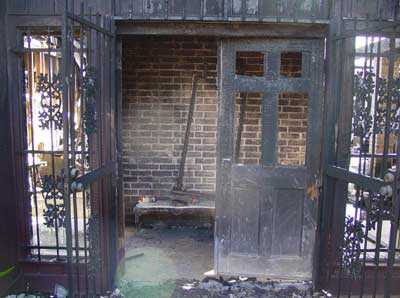
|
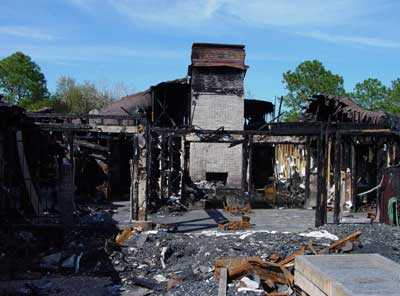
|
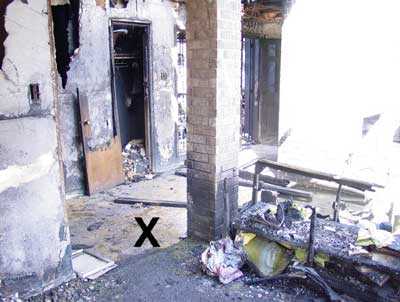
|
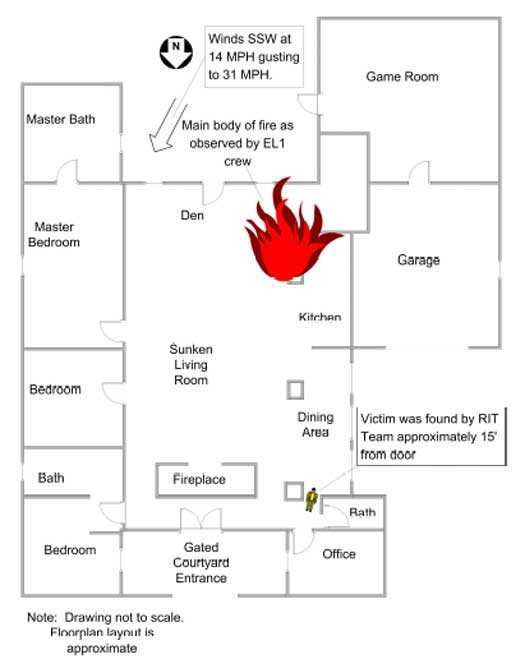
|

|
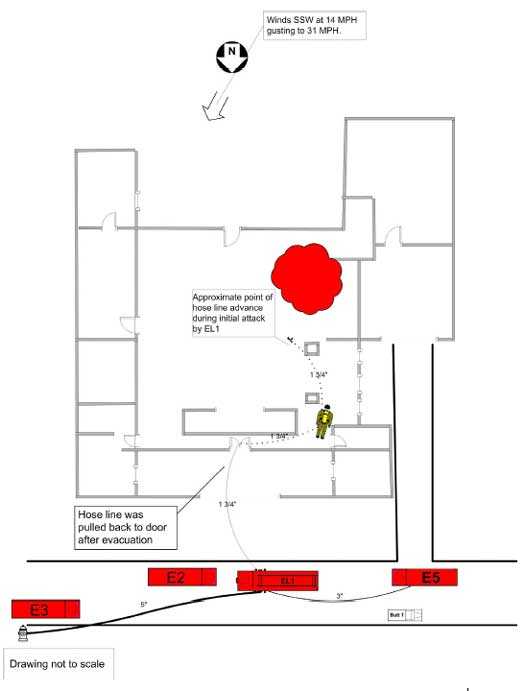
|
|
Diagram 3. Depicts the initial hose-line advance. Note the dotted line.
|
This page was last updated on 10/04/05.
- Page last reviewed: November 18, 2015
- Page last updated: October 15, 2014
- Content source:
- National Institute for Occupational Safety and Health Division of Safety Research


 ShareCompartir
ShareCompartir
